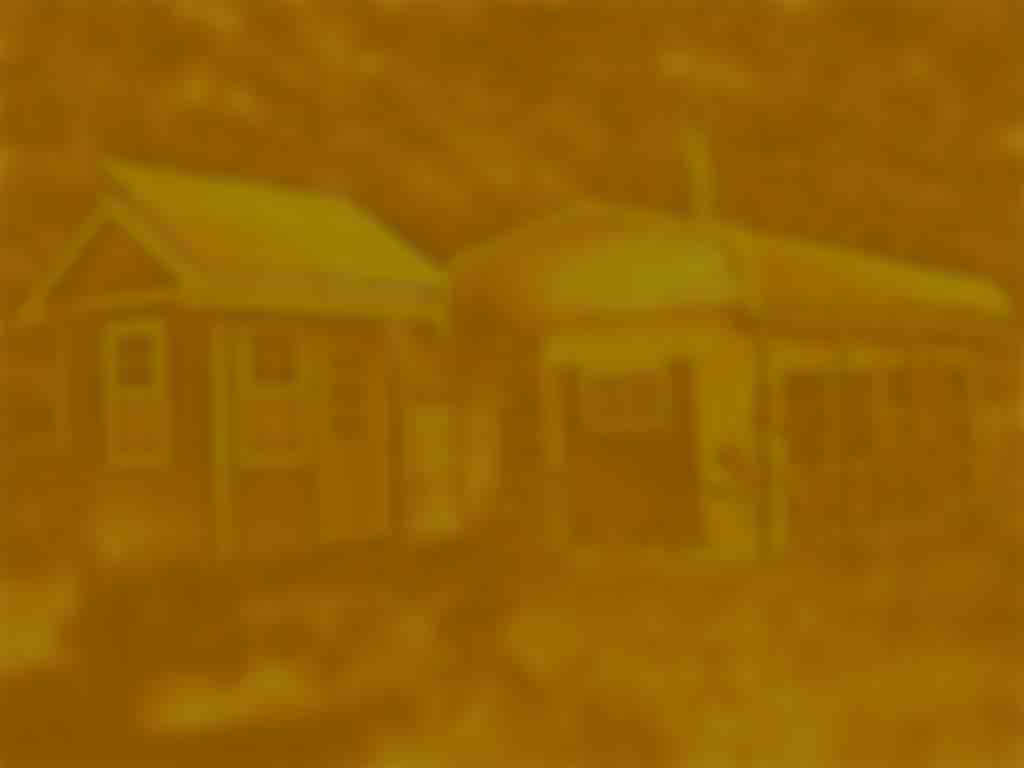|
|
|
Back to the beginning:
 We left The Cape on November 17th, 2007 in our new Prius. In prior years we had rented vehicles for this trip, concerned that the old Caddy might not make it. Then we would drive around California in the Dodge van that lives there year around. With the growing price of gas the Prius proved to be a God-send averaging 46+ MPG. Others have said that they were getting 55 MPG but I do not think they did the math. Toyota ads had hyped a 55 MPG rumor. They were reprimanded for this misinformation and they cut it out but some owners still choose to use that figure as bragging rights. I think 46 MPG is darn good. The gas tank only holds 11.9 gallons and yet we only stopped for 7 fill-ups during the 3000+ mile trip, including one sometime after we arrived.
We left The Cape on November 17th, 2007 in our new Prius. In prior years we had rented vehicles for this trip, concerned that the old Caddy might not make it. Then we would drive around California in the Dodge van that lives there year around. With the growing price of gas the Prius proved to be a God-send averaging 46+ MPG. Others have said that they were getting 55 MPG but I do not think they did the math. Toyota ads had hyped a 55 MPG rumor. They were reprimanded for this misinformation and they cut it out but some owners still choose to use that figure as bragging rights. I think 46 MPG is darn good. The gas tank only holds 11.9 gallons and yet we only stopped for 7 fill-ups during the 3000+ mile trip, including one sometime after we arrived.
The GPS:
I also had my GPS to guide us so we did not have to do the map thing, even when we diverted around the famous Harrisburg traffic by taking back roads and highways to the south. That took us through Gettysburg where almost everybody was decked out in Union and Confederate uniforms and southern belle dresses. They really seemed to be getting along with each other too. I tend to suspect that the apparel was a heck of a lot cleaner and more comfortable then the real thing had been 144 years prior.
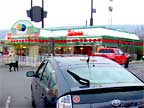 This GPS is a TomTom One. I do not recommend it. I have learned the hard way to copy the contents of the SD memory card to a folder on my computer because the device and/or its TomTom Home software occasionally corrupts the card such that the device does not work. I cannot pin down the exact sequence of events that cause this to happen; it seems random. Likewise, in case I don't have my computer with me, I copy the contents of that folder onto another SD card which I keep in the car. Then it is a simple matter of switching the cards when one stops working. I then reload the corrupted card from the saved folder ASAP and it becomes the spare. My requests for tech support got nowhere: “Try this; Try that”. They should have just sent me a new one with a prepaid package for returning the old as HP did with a questionable camera a few years ago. The funny thing here is that HP is now selling their own GPS unit with, guess what, the TomTom firmware installed. My next GPS will not be a TomTom or an HP.
This GPS is a TomTom One. I do not recommend it. I have learned the hard way to copy the contents of the SD memory card to a folder on my computer because the device and/or its TomTom Home software occasionally corrupts the card such that the device does not work. I cannot pin down the exact sequence of events that cause this to happen; it seems random. Likewise, in case I don't have my computer with me, I copy the contents of that folder onto another SD card which I keep in the car. Then it is a simple matter of switching the cards when one stops working. I then reload the corrupted card from the saved folder ASAP and it becomes the spare. My requests for tech support got nowhere: “Try this; Try that”. They should have just sent me a new one with a prepaid package for returning the old as HP did with a questionable camera a few years ago. The funny thing here is that HP is now selling their own GPS unit with, guess what, the TomTom firmware installed. My next GPS will not be a TomTom or an HP.When it works, it is wonderful; it guides me to where I'm going verbally so that I can keep my eyes on the road, and visually so that I can also get the layout ahead. It's USA map is not always up to date and the cost of upgrading that map was cost prohibitive a year ago. For example, Perris, California totally recreated their road system a few years back. We drive through there on our way to Laguna. As of last summer TomTom did not yet have the new road system in my version of their map so in Perris we get lost. I seem to remember the USA map being close to $90 a year ago so I declined. Now they are asking $40 list but $30 if I get it now on sale. I may spring for that. However, when I called tech support a year ago about a corrupted card, the guy gave me a new map so I could reload the card, but it still did not get Perris right.
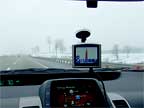
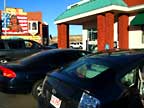
The main reason I like to leave in November is to avoid running into snow and ice – and the road salts that destroy the undercarriage of a vehicle over time. We did not entirely make it unscathed. After spending the night near Gettysburg we travelled up and west through the Pennsylvania mountains where we did encounter snow, a beautiful sight but still a little disconcerting. To see why I am a bit wary, read about an almost near death experience a few years back in Virginia and Tennessee.
Havasu:
The GPS did guide us to a new byway that I had been curious about, a man-made lake out in the middle of nowhere on the Colorado River. Though the river does go through many significant places like the Grand Canyon, the Hoover Dam and eventually trickles into Mexico it also goes through a lot of nowhere. The lake I'm talking about is
Havasu which is north of where I-10 crosses the river into California, and south of where I-40 crosses over.
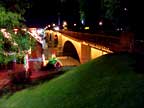

It was an adventurous entrepreneur in
Lake Havasu City that purchased the stately
London Bridge in 1962 for 2.5 million. It was disassembled, shipped over and reconstructed entirely on dry land near the lake. In fact it was assembled over a series of sand mounds shaped to support the arches. Then the mounds were removed and a channel was excavated from the lake, under the bridge and back out to the lake. This created an island at the west end of the bridge, an island now of green space, a golf course, marina, beaches and exclusive homes.
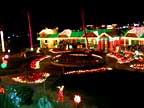 It was an amazing sight to see as we passed over a meandering collection of English shops lining the water and then across the water to the island. Blankets of Christmas lighting covered those shops and the gardens around them. We just happened to be driving by late on November 21 when
It was an amazing sight to see as we passed over a meandering collection of English shops lining the water and then across the water to the island. Blankets of Christmas lighting covered those shops and the gardens around them. We just happened to be driving by late on November 21 when
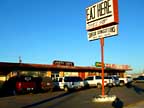 the multicolored blankets were switched on for testing, then off awhile later to await the season. That was quite a sight to see.
the multicolored blankets were switched on for testing, then off awhile later to await the season. That was quite a sight to see.
In the morning, Thanksgiving Day, we headed south and then west below the
Parker Dam, the deepest dam in the world, they say. We ate breakfast at the Early Bird Café which the GPS found for us in Parker, and then on to Joshua Tree, a 3+ hour drive over all.
We had arrived and it all looked good. We ate Thanksgiving dinner that evening at Jerry's Restaurant in Yucca Valley.
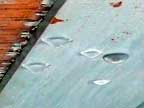
The Roof:
It had not rained seriously in months, not since it dampened the soil with 0.08 inches in September. On November 30, a week and a day after our arrival, it rained over an inch – inside. Thank God I was there. Though I could not do much about the water dripping from the kitchen ceiling like the bottom of a wet sponge, at least I could catch most of it in a basin.
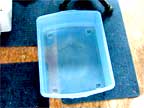 It is often difficult to tell where a leak originates but my best guess was that the rain was puddling on the flat roof and then draining in around the old ceiling vent at the front. I had siliconed and painted all of that a few years before but just the act of crawling on that old tin roof to do so could open hidden cracks in the seams. It was also rusting away where the puddles had formed over the years.
It is often difficult to tell where a leak originates but my best guess was that the rain was puddling on the flat roof and then draining in around the old ceiling vent at the front. I had siliconed and painted all of that a few years before but just the act of crawling on that old tin roof to do so could open hidden cracks in the seams. It was also rusting away where the puddles had formed over the years.
That's it! I was done constantly trying to repair this roof. I had naively replaced the original masonite siding with ¼” plywood in 1969, including the curved shoulders that wrap all the way around. This made it considerably heavier, but also where the masonite would have held its shape, the plywood gradually separated between the plys and split along its grain. Also, that re-siding 40 years ago had wiped out it antique character, something I had not even considered back then but cared about now. For that reason over the last 7 years I had endeavored to maintain the trailer in what was left of its original condition, repairing rather than replacing.
I also liked the look of it sitting proud and pretty on top of its cradle with no distractions. It was a showpiece of pre-aluminum trailer workmanship, along the idea of the antique chrome diners around the country that have been rejuvenated to their classic mid-20th century character.

It wasn't working. It was our west coast home and we had to be able to live in it comfortably. My first step was to throw 2 brown tarps over the whole thing securely tied to long PVC pipes which in turn were roped to the frame under the trailer. I had also laid a sponge mattress pad under the front tarp to absorb the sharp angles of the tin roof's exoskeleton. It was makeshift, its look was gone, and it was disheartening, but it stopped the leaks.
I had known this day was coming. I had occasionally entertained the idea of a free-standing shingled roof matching that of the utility house but erected on a framework of 4x4 posts. That would have been hard to properly support and still maintain an open look. It would effectively hide the trailer behind a lattice work of timbers. It would also have taken a long time to build and I already had a full-time project in the works, meaning it would not be protecting the trailer until next year sometime. I clearly needed a solution now.
I had also been seeing these metal carport roofs here and there in my travels, even stopped and took pictures of one. Though not exactly ascetically pleasing they certainly appeared as though they would do the job. I had casually researched them from time to time online. Now I had to take a serious look to see if they could hold up to high winds, if they could be securely attached to my deck's framework, what they would cost, and to see what others had to say about them. That and email conversations with various suppliers began sometime in December.
I had to think in terms selecting a carport that would wrap around the trailer with plenty of clearance at the sides (not just the peak) to keep it from contacting the trailer. Though unlikely if not impossible, the trailer might have to be moved one day. It is more likely that it will need to bounce around some during an earthquake. It rests entirely on one solid beam where it used to rest on wheels, and then on the trailer tongue's post at the front. The trailer is not attached anywhere; the wooden frame below cradles it so that it should absorb whatever nature throws its way. I wanted enough clearance to allow for that potential movement.

First I measured everything. The trailer is 19' 9” long, excluding the tongue, by 7' 6” wide edge to edge. When including the overhang of the awning roof at the rear the length becomes 20' 7”. At the center of the rear vent on top it is 7' 4” from the deck surface. However since the tongue can be adjusted up and down, we need to allow another 12” or so at the front and the rear. The deck's 2x8 joists that run the length of the trailer are 9' 1” apart center to center at the rear. At the front the same joists are 8' 8” apart.
 On February 4, 2008 at
Carports.Com I purchased a dark brown round shouldered
Carolina Carport with white trim for $935. It was surprisingly less expensive then I had expected and yet it proved to be sturdier then expected. The roof was 10' wide by 21' long by 7' high at the legs and 9' at the peak, more than enough to protect the trailer. It would also provide some welcome shade on hot days.
On February 4, 2008 at
Carports.Com I purchased a dark brown round shouldered
Carolina Carport with white trim for $935. It was surprisingly less expensive then I had expected and yet it proved to be sturdier then expected. The roof was 10' wide by 21' long by 7' high at the legs and 9' at the peak, more than enough to protect the trailer. It would also provide some welcome shade on hot days.
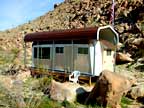 The truck backed into my driveway at 5:57 AM on March 10. I drank coffee, took pictures and watched as three Hispanic acrobats raised the structure around my trailer piece by piece. At 7:26 they drove away heading to their next installation in Indio, California. The man in charge was Sergio Lopez, a contractor out of Fresno, California. Rarely did they even touch the trailer and there were no additional charges for unexpected difficulties though the contract did allow for that. The corrugated sheet-metal roof panels had a crimp in them which I assume was caused by the wind catching them on the trip down from Fresno, but that is relatively insignificant; it looks good.
The truck backed into my driveway at 5:57 AM on March 10. I drank coffee, took pictures and watched as three Hispanic acrobats raised the structure around my trailer piece by piece. At 7:26 they drove away heading to their next installation in Indio, California. The man in charge was Sergio Lopez, a contractor out of Fresno, California. Rarely did they even touch the trailer and there were no additional charges for unexpected difficulties though the contract did allow for that. The corrugated sheet-metal roof panels had a crimp in them which I assume was caused by the wind catching them on the trip down from Fresno, but that is relatively insignificant; it looks good.
The roof is firmly attached on both sides to a steel framework of five 2.5” square legs attached to an equally square 20' sill, all 14 gauge. A similar but reinforced arch passes over the trailer from the top of each leg to its opposite twin. As anticipated, the north side frame does bisect the deck distracting from its look and getting in the way at the narrow end of the elongated piano shaped deck. I plan to cut and redirect at least two of the legs and their section of the sill to get them out of the way. The deck is solid, itself steel straped and screwed to 18 short 4x4 posts, 15 of which are anchored to concrete footings.
In the end the only really unfortunate circumstance was that there were no more rains after that. I was unable to stand there and watch the rain not hitting the trailer roof before I departed on May 8. The future awaits me.
The entire procedure is depicted in a pictorial essay accessible from the
2007 Joshua Tree site.
The Other Recalcitrant Roof:
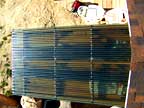 At about the same time I discovered that the roof over the old utility trailer, now a permanent appendage of the utility house, was leaking. Since I had built that roof of corrugated panels with great diligence last year this was discouraging. The roof itself did not leak; the heavy windblown rain was coming through ventilation openings where the roof penetrates the wall of the house.
At about the same time I discovered that the roof over the old utility trailer, now a permanent appendage of the utility house, was leaking. Since I had built that roof of corrugated panels with great diligence last year this was discouraging. The roof itself did not leak; the heavy windblown rain was coming through ventilation openings where the roof penetrates the wall of the house.
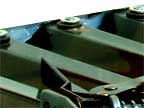 I had thought that the wall itself and then the utility house's own roof overhang would provide enough protection, but apparently not. I think the corrugations were serving as channels for the wind to push the water uphill through the wall openings.
I had thought that the wall itself and then the utility house's own roof overhang would provide enough protection, but apparently not. I think the corrugations were serving as channels for the wind to push the water uphill through the wall openings.
Now I have plugged those openings with globs of silicone sealant, still leaving a very slight hole above each glob for ventilation. I also added 4 standard variety 3” louvered screened vents in the side walls under this roof.
Jean:
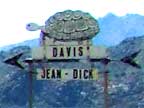 I did a short piece on our friend Jean Davis in the
2005 Joshua Tree web site. She has moved to an assisted living facility on the other side of Yucca. Her home is on the market. She and Dick welcomed me to the neighborhood in 1967. When Dick passed away she remained. It was a pleasant surprise to find her here when we returned in 2001. She is the one that got us attending the local playhouse which Dick helped build and she continued to participate in as an usher and all around worker. She also volunteered with the local Hospice.
I did a short piece on our friend Jean Davis in the
2005 Joshua Tree web site. She has moved to an assisted living facility on the other side of Yucca. Her home is on the market. She and Dick welcomed me to the neighborhood in 1967. When Dick passed away she remained. It was a pleasant surprise to find her here when we returned in 2001. She is the one that got us attending the local playhouse which Dick helped build and she continued to participate in as an usher and all around worker. She also volunteered with the local Hospice.
Apparently she had fallen to the floor, probably a minor stroke, and laid there overnight until an alert friend found her the next day. We heard about it when Eileen discovered one of her sons and his wife throwing much of her stuff out in the trash. That included an unmailed Christmas card to us (she didn't have our address) that the wife had found and was kind enough to mention when Eileen stopped in. We visited her in the hospital. She was bruised and seriously dehydrated but otherwise okay, considering. They kept her there for a month.
She is 87 now and the last I heard (from her other son) she was getting around on her own and doing well. We will look her up when we return.
|
Copyright © 2008, Van Blakeman |
